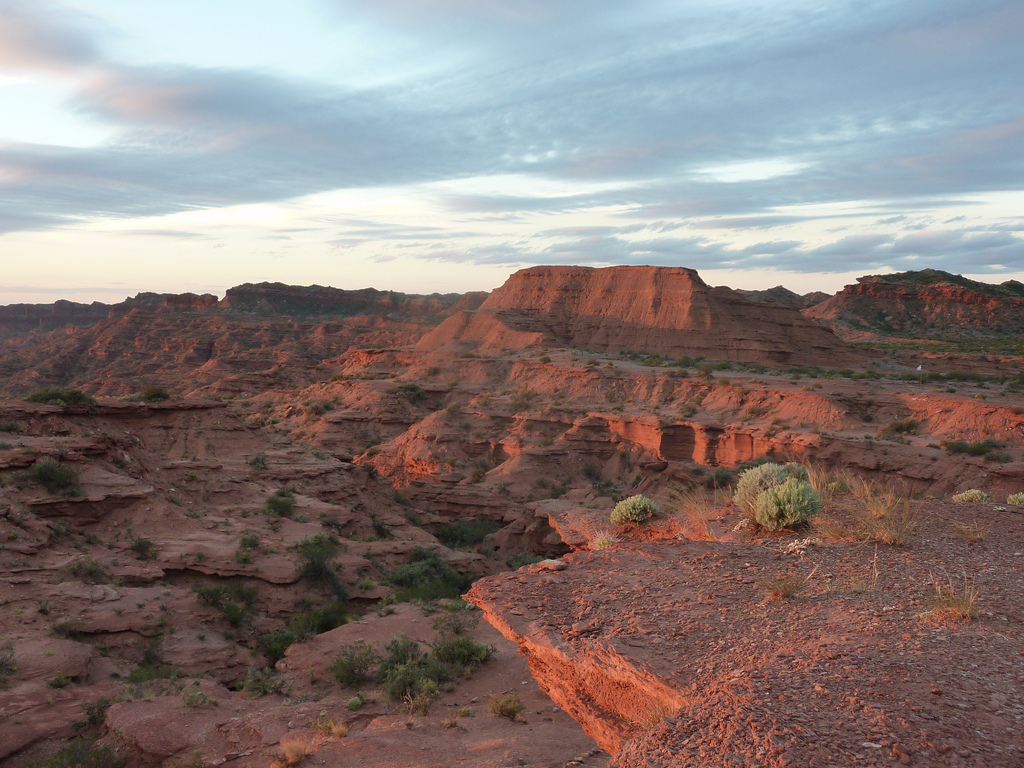
Sunset at Parque Nacional Sierra de las Quijadas. Photo © Dave Lonsdale
Evoking the red sandstone ravines of Utah’s Bryce Canyon, Parque Nacional Sierra de las Quijadas is rich in scenery, fossils, and pre-Columbian archaeological sites. In Lower Cretaceous times, about 120 million years ago, pterosaurs and their contemporaries left tracks in a semiarid landscape that has since become a jumble of barren cliffs, cornices, terraces, and desiccated lakebeds. Far later, the Huarpe and their predecessors left evidence of their camps and settlements. …the park is the subject of ongoing paleontological research by Universidad Nacional de San Luis and New York’s Museum of Natural History…Comprising 74,000 hectares in northwestern San Luis Province, the park is the subject of ongoing paleontological research by Universidad Nacional de San Luis and New York’s Museum of Natural History as well as excavations of early Huarpe sites. Badly in need of its own interpretive center, it’s open all year, but the mild spring and autumn months are best for visits; in the suffocating summer, thunderstorms can cause dangerous flash floods. The provincial government has initiated a request for UNESCO World Heritage Site status as part of a paleontology circuit with Ischigualasto (San Juan) and Talampaya (La Rioja).Las Quijadas is about 120 kilometers northwest of San Luis via paved RN 147 and a signed six-kilometer westbound gravel lateral. Most of the enormous park, though, is accessible only on foot.
When the pterosaurs roamed here, Las Quijadas was a mostly level marshland, but climate changes over 100 million years have left it a desert where summer temperatures often exceed 40°C, and plants and animals have adapted to this regime. Typical of the flora is the endemic chica, a small slow-growing tree whose hard, dense wood forms a twisted trunk. Truncated shrubs like the jarilla and several species of cacti are also typical.
The most notable mammals are the collared peccary, guanaco, puma, and red fox; the endangered Argentine land turtle is also present here. Peregrine falcons and other raptors dive for small prey, while the Andean condor soars in search of carrion.
Las Quijadas’s most unforgettable sight is the natural amphitheater of Potrero de la Aguada, where the last 25 million years of runoff—from precipitation that now averages only 300 millimeters per annum—has eroded ancient sediments to expose bright sandstone beds and conglomerates to the west. An easy trail follows the Aguada’s rim toward the south for about half an hour, but hikers should refrain from descending into the intricate canyons without plenty of water, high-energy snacks, and an obligatory local guide.
Along the gravel road to Potrero de la Aguada, stop at the recently excavated Hornillos Huarpes, the ovens where the park’s pre-Columbian inhabitants prepared their meals and fired their ceramics. These have been carbon-14 dated at about a.d. 1000.
About one kilometer east of the Potrero de la Aguada overlook, there’s a free APN campground with clean flush toilets as well as a small grocery with snacks and cold drinks.
There’s still no formal visitors center, but rangers at the park entrance (who collect a US$7 admission for foreigners, US$2 for Argentine residents) provide maps and can answer questions. At the campground, local guides offer several reasonably priced (around US$7–10 pp) 3–4-hour hikes into the badlands, though none of them can manage English.
Spanish-speaking visitors to San Luis should look for the self-published guidebook El Parque Nacional Sierra de las Quijadas y Sus Recursos Naturales by English-speaking geologist David Rivarola (tel. 02652/15-54-3629, [email protected]), who offers the most informative park tours, but because of time demands only does so for large groups and for foreigners in particular.
Buses between San Luis and San Juan can drop passengers on the access road just north of the hamlet of Hualtarán. Travel agencies in San Luis sometimes organize day tours.
Excerpted from the Third Edition of Moon Argentina.